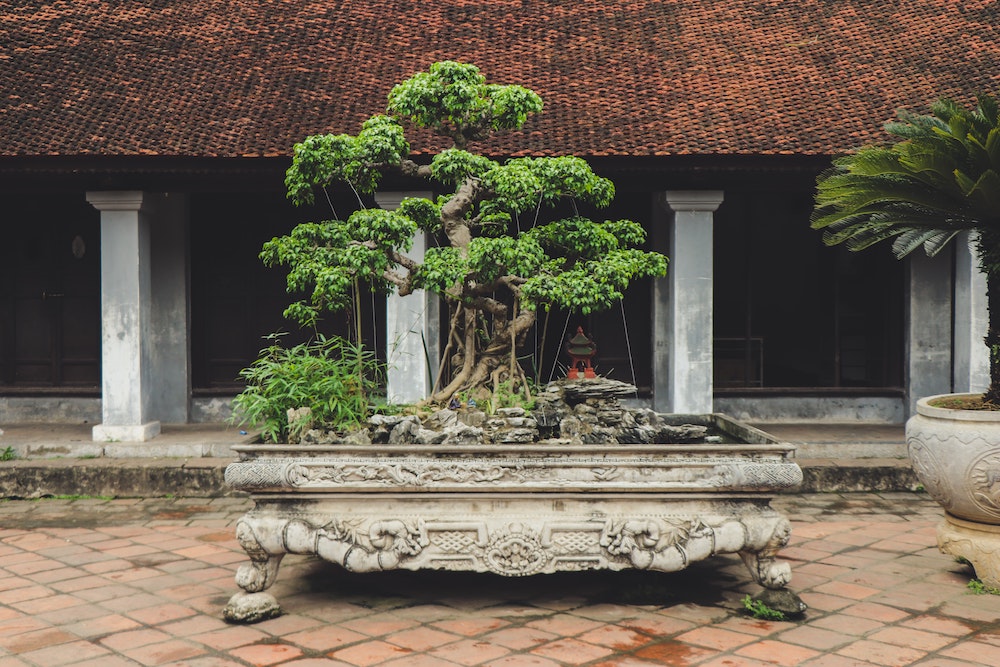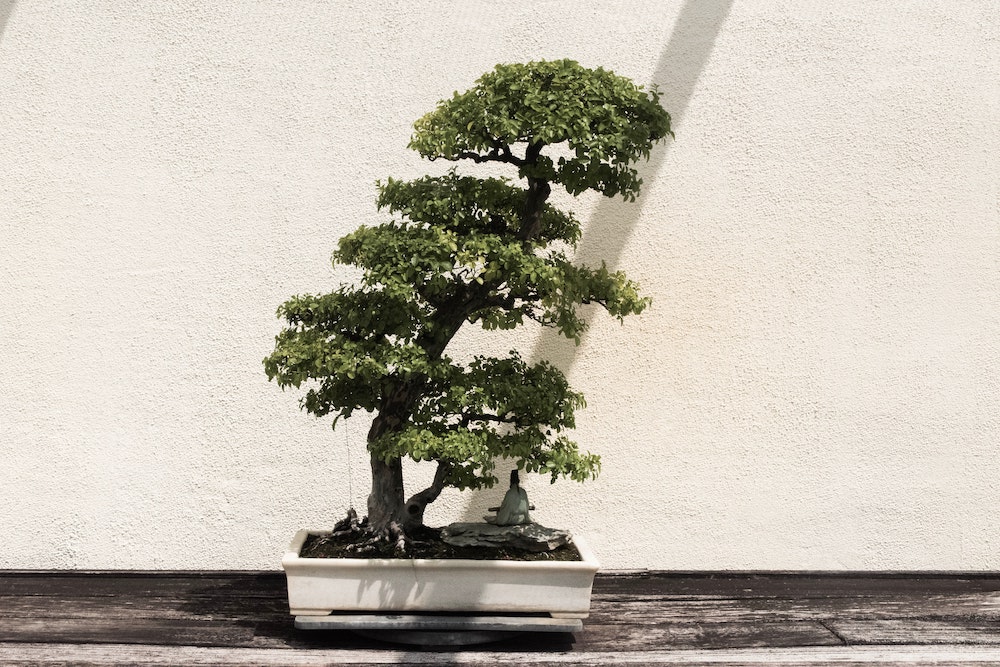Discover the art of bonsai tree cultivation: from history and styles to techniques and tools, learn all you need to know to grow your own masterpiece.
Bonsai is a Japanese art form that has been practiced for over a thousand years. It involves cultivating and training small trees in pots, creating miniature versions of their full-grown counterparts. The goal is to create a perfectly balanced and harmonious miniature representation of a full-sized tree.
Bonsai is more than just a simple gardening technique. It is an expression of the balance between nature and human intervention. A bonsai tree symbolizes the harmony between man and nature, and it is an art that requires skill, patience, and dedication.
In this article, we will explore the history and origins of bonsai, the different types of bonsai trees, how to care for them, and the tools and techniques used in bonsai cultivation.
Contents
- The Origins and History of Bonsai
- Types of Bonsai Trees
- Choosing a Bonsai Tree
- Bonsai Soil and Potting
- Watering and Fertilizing Bonsai Trees
- Thickening a Bonsai Tree
- Pruning and Training Bonsai Trees
- Repotting Bonsai Trees
- Common Bonsai Pests and Diseases
- Tools and Techniques Used in Bonsai Cultivation
- References
The Origins and History of Bonsai
The art of bonsai originated in China over a thousand years ago. It was then brought to Japan by Buddhist monks who used bonsai trees as an aid to meditation. The Japanese developed bonsai as a unique art form, and it was not until the 20th century that it was introduced to the Western world.
The word bonsai is derived from two Japanese words: “bon” meaning tray or pot, and “sai” meaning plant or tree. Bonsai trees were traditionally grown in small pots, often with intricate designs, and were intended to be viewed from a single perspective, much like a painting or sculpture.
Bonsai trees were initially reserved for the wealthy, but eventually became more widely available and popular among people of all social classes. Today, bonsai is practiced all over the world, and there are many different styles and techniques used in its cultivation.
Types of Bonsai Trees
There are several different types of bonsai trees, each with its own unique characteristics and requirements. Some of the most common types of bonsai trees include:
Pine Bonsai Trees
These are the most popular type of bonsai trees and are known for their rugged appearance and long, slender needles.
Maple Bonsai Trees
These trees are prized for their vibrant colors in the fall and their unique leaf shapes.
Juniper Bonsai Trees
Junipers are evergreen trees that are easy to care for and are ideal for beginners.
Ficus Bonsai Trees
Ficus trees are tropical trees that are well-suited to indoor growing and can be trained into a variety of shapes and styles.
Elm Bonsai Trees
Elm trees are hardy and can be trained into many different styles, including the classic “windswept” look.
Choosing a Bonsai Tree
Choosing the right bonsai tree is an essential step in bonsai cultivation. It is important to consider the following factors when choosing a bonsai tree:
Climate for Bonsai Tree
Different bonsai trees have different climate requirements, and it is important to choose a tree that is well-suited to your climate.
Size
Bonsai trees come in many different sizes, from tiny trees that fit in the palm of your hand to larger trees that can be several feet tall. It is important to choose a tree that fits your space and lifestyle.
Style
Different bonsai trees have different styles, from the classic formal upright style to the informal slanting style. It is important to choose a style that appeals to you and fits with the overall design of your bonsai collection.
Age
Bonsai trees can take many years to grow and mature, so it is important to consider the age of the tree when making a purchase. Older trees can be more expensive, but they also have more character and are often more desirable.
Bonsai Tree Soil and Potting
The soil used in bonsai cultivation is a critical factor in the health and growth of the tree. Bonsai soil must be well-draining and allow for proper air circulation around the roots. There are several different types of soil that can be used for bonsai cultivation, including:
Akadama
A type of volcanic clay that is widely used in Japan and is prized for its ability to retain water while allowing for proper drainage.
Pumice
A lightweight volcanic rock that is used for its ability to provide excellent drainage while retaining some moisture.
Peat moss
A natural material that is used to help retain moisture in the soil.
Perlite
A lightweight volcanic glass that is used to improve soil drainage.
When potting a bonsai tree, it is important to choose a pot that is appropriate for the size of the tree and the style of the bonsai. The pot should be slightly larger than the root ball of the tree, and should have drainage holes to allow excess water to escape.
Watering and Fertilizing a Bonsai Tree
Proper watering and fertilization are essential for the health and growth of a bonsai tree. Bonsai trees should be watered when the soil is slightly dry to the touch, but not completely dry. Overwatering can lead to root rot, while underwatering can cause the tree to dry out and die.
Fertilization is also important, as bonsai trees require a regular supply of nutrients to grow and thrive. There are many different types of fertilizers that can be used for bonsai cultivation, including organic and inorganic fertilizers.

Bonsai trees are a beautiful and rewarding hobby that requires patience, dedication, and a willingness to learn. Whether you are a beginner or an experienced bonsai enthusiast, there is always something new to discover and explore in the world of bonsai cultivation.
Thickening a Bonsai Tree
Thickening the trunk is an important aspect of developing a bonsai tree. It involves encouraging the tree’s trunk to become thicker and stronger over time. The process can take several years or even decades, depending on the species of the tree and the desired outcome.
One common technique for thickening the trunk is known as “clip and grow.” This involves allowing the tree to grow freely and then periodically pruning back the new growth to a few leaves or buds. By doing so, the tree is forced to redirect its energy into producing new branches and foliage, which in turn leads to a thicker trunk. Another technique is called “growing out,” which involves allowing the tree to grow unchecked for a period of time before cutting it back. This technique is often used for younger trees that are still in the early stages of development.
Pruning and Training Bonsai Trees
Pruning and training are essential techniques used in bonsai cultivation to shape and maintain the tree’s form and size. Pruning involves the removal of unwanted branches and leaves, while training involves the use of wire and other techniques to shape the tree into a desired form.
The timing and frequency of pruning and training will depend on the species of bonsai tree, as well as the desired style and shape. It is important to use proper tools and techniques when pruning and training a bonsai tree, as improper techniques can damage or even kill the tree.
Repotting a Bonsai Tree
Bonsai trees should be repotted every few years to prevent the roots from becoming bound and to provide fresh soil and nutrients to the tree. The best time to repot a bonsai is during the spring, just before the tree begins its active growth phase.
To repot a bonsai tree, carefully remove the tree from its pot and gently loosen the roots from the soil. Trim any damaged or tangled roots, and then repot the tree in fresh bonsai soil in a slightly larger pot. Water the tree thoroughly after repotting to help settle the soil.
Bonsai Tree Pests and Diseases
Bonsai trees are susceptible to a variety of pests and diseases, including spider mites, scale insects, and root rot. It is important to regularly inspect your bonsai tree for signs of pests or disease, and to take prompt action to address any issues that arise.
Preventative measures such as regular cleaning and good cultural practices can help to minimize the risk of pest and disease problems. If pests or disease are detected, there are a variety of treatments available, including insecticides, fungicides, and other chemical or natural remedies.
Tools and Techniques Used in Bonsai Cultivation
Bonsai cultivation requires a variety of specialized tools and techniques to shape, prune, and maintain the tree’s form and health. Some of the most commonly used tools and techniques in bonsai cultivation include:
Pruning shears – Used to remove unwanted branches and leaves from the tree.
Concave cutters – Used to make clean cuts in branches and twigs, leaving a concave surface that will heal quickly and smoothly.
Wire – Used to bend and shape the branches and trunk of the tree into the desired form.
Root rake – Used to gently remove soil and untangle the roots of the tree during repotting.
Soil sieve – Used to sift and remove debris from bonsai soil.
Bonsai turntable – Used to easily rotate the tree while working on it.
Jin pliers – Used to create deadwood features on the tree by stripping bark and wood from the trunk and branches.
Watering can – Used to water the tree, ensuring that it receives the appropriate amount of moisture.
In addition to these tools, there are several techniques used in bonsai cultivation that require a delicate touch and careful attention to detail. These include:
Wiring – A technique used to bend and shape the branches of the tree into the desired form. Wire is wrapped around the branch and carefully tightened to create the desired angle and shape.
Pruning – A technique used to remove unwanted branches and leaves from the tree. Pruning helps to maintain the tree’s shape and promote healthy growth.
Repotting – A technique used to refresh the soil and provide the tree with fresh nutrients. Repotting should be done every few years to prevent the roots from becoming bound.
Deadwood carving – A technique used to create deadwood features on the tree, such as hollowed-out sections, scars, and texture. This technique requires a steady hand and a knowledge of the tree’s anatomy.
Defoliation – A technique used to remove the leaves from the tree in order to encourage new growth and promote ramification. This technique is typically done in early summer and requires careful monitoring of the tree’s health.
By using these tools and techniques effectively, bonsai enthusiasts can create stunning and unique works of living art that bring beauty and tranquility to any space.
Bonsai trees are a beautiful and rewarding hobby that requires patience, dedication, and a willingness to learn. Whether you are a beginner or an experienced bonsai enthusiast, there is always something new to discover and explore in the world of bonsai cultivation.
By understanding the basics of bonsai care, including proper watering, fertilization, pruning, and training techniques, you can help ensure the health and vitality of your bonsai tree for years to come.
So whether you are looking to create a stunning bonsai display in your home or garden, or simply to enjoy the beauty and tranquility of a miniature tree, there is no better time to get started with bonsai cultivation than today.
References
- Chan, H. & Hsu, E. (2015). The art of bonsai: A beginner’s guide to growing bonsai. New York, NY: Sterling Publishing Co., Inc.
- D’Cruz, M. (2018). Bonsai: A beginner’s guide to growing, maintaining, and shaping bonsai trees. San Francisco, CA: Chronicle Books.
- Hillier, M. (2002). The complete book of bonsai. New York, NY: DK Publishing, Inc.
- Lewis, C. (2014). Bonsai basics: A step-by-step guide to growing, training and general care. New York, NY: Quarto Publishing Group.
- Naka, J. Y. (2014). Bonsai techniques II. Fresno, CA: Bonsai Institute of California.
- Tomlinson, H. (2003). The complete illustrated guide to growing bonsai. New York, NY: Sterling Publishing Co., Inc.
- Bonsai Empire. (n.d.). Bonsai styles. https://www.bonsaiempire.com/basics/styles
- International Bonsai. (n.d.). History of bonsai. https://www.internationalbonsai.com/pages/history-of-bonsai
- American Bonsai Society. (n.d.). Bonsai styles. https://absbonsai.org/styles/
- Bonsai Clubs International. (n.d.). Bonsai soil basics. https://www.bonsaiclubsintl.com/Articles/Bonsai-Soil-Basics
- Google Analytics for Beginners: Guide to Mastering Analytics - July 28, 2023
- National SEO for Lawyers: Drive Nationwide Traffic for Your Firm - July 28, 2023
- The Power of Local SEO for Lawyers: Build Your Practice - July 28, 2023


